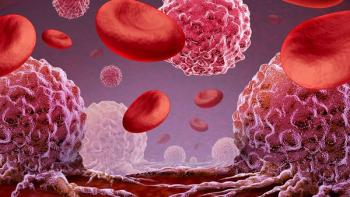
Dangers of DVT
Knowing your risk for blood clots may help to prevent them.
Blood clots are usually tiny, just millimeters really, barely the size of any letter in this sentence. Yet something so small can have a profound impact, either by saving lives or threatening them.
There is a delicate balancing act that keeps blood liquid enough to travel through the circulatory system but able to gel at a second’s notice. When that balance tips too much in one direction, a blood clot can develop and lead to heart attack, stroke or deep vein thrombosis (DVT), a common condition in cancer patients. DVTs are clots that form in deep veins, such as those deep in the legs.
Venous thromboemboli (VTE) are clots that can dislodge and begin traveling down the vein. VTE include DVTs and pulmonary embolis—clots that form and travel through the heart and to the lungs. These can be potentially dangerous because they can cut off blood and oxygen to the lung tissue and make the heart work harder. Cancer patients are more prone to blood clots due to several risk factors associated with cancer:
• Cancer type: Cancer of the pancreas, ovaries, stomach, lung and brain, for example, are notorious for causing clots.
• Cancer stage: Patients with metastatic disease are more prone to clotting problems than people with early-stage disease.
• Treatment: Some therapies, such as hormone therapy, can increase risk. Surgery and implanted ports also increase risk.
• Immobility: Clots can form following surgery, bone fracture or other injury.
• Congestive heart failure or abnormal heart rhythm, particularly atrial fibrillation, which usually requires anticoagulation.
Cancer patients have six times the risk of VTE as people without cancer, depending on cancer type . To treat or prevent such conditions, physicians use anticoagulants (known as blood thinners in lay terms), either low molecular weight heparin (LMWH), such as Fragmin (dalteparin) or Lovenox (enoxaparin), or the oral agent warfarin (brand names include Coumadin and Jantoven).
Physicians prefer LMWH for cancer patients—it allows the patient to give themselves daily injections with a tiny needle and they don’t need to be monitored, which saves trips to the doctor and extra blood tests, says Ramaswamy Gonvindan, MD, professor in the division of hematology and oncology at Washington University School of Medicine in St. Louis, Mo.
But sometimes, even LMWH isn’t ideal. Cancer patients find themselves on the receiving end of daily needle sticks as part of their treatment. Some patients don’t tolerate the injections or may not have access to the drug, says Harry Büller, MD, PhD, professor of medicine in the Academic Medical Center Amsterdam, The Netherlands. Büller is lead author of the recently published
The study showed that rivaroxaban worked well in all groups. Because the trial was not exclusive to cancer patients, a larger study comparing rivaroxaban with LMWH in cancer patients is in the works, says Büller.
Although rivaroxaban appeared to have fewer side effects than warfarin, all anticoagulants carry the risk of unwanted bleeding, among other adverse events.
“Treatment for blood clots is not benign because the medications carry a significant risk for bad side effects. Cancer patients can have recurrence even when they’re on treatment and undergoing a lot of monitoring,” says Carmen Escalante MD, chair of general internal medicine, M.D. Anderson Cancer Center in Houston.
Patients on warfarin have to be aware of drug interactions because some drugs can make warfarin more or less effective. People on warfarin need frequent blood tests to adjust the dose and may need to restrict certain foods high in vitamin K such as spinach, which can interfere with the drug. Risk of bleeding is the most serious side effect, so patients have to be careful of physical activity that could lead to falls and cuts. People on blood thinners also have to make certain all care providers know they are taking the drugs. Procedures that may cause bleeding, such as getting teeth cleaned, may have to be postponed.
Nancy Zieber RN, CRNP, an oncology nurse practitioner at the Joan Karnell Cancer Center at Pennsylvania Hospital in Philadelphia, says that swelling in patients with clots in their lower extremities can last years after cancer and ulcerate skin. To prevent such occurrences, some patients at the center deemed to be high risk are put on LMWH as a preventive measure.
Zieber cautions cancer patients to watch for symptoms of DVT, such as pain, swelling and discoloration, and modify their lifestyle, including quitting smoking, staying hydrated and adding exercise, such as walking. (For more information on symptoms of DVT and management, see “
Identifying cancer patients at risk of clots could perhaps prevent or help treat them more effectively. This past December, the American Society of Hematology, during its annual meeting, released a
The scientists developed a scoring system that stratified patients with cancer-associated VTE into high and low risk based on gender, primary tumor site, malignancy stage and history of VTE. For example, high-risk characteristics included prior history of VTE, lung cancer and female sex, but not early-stage disease and breast cancer, which were considered lower-risk traits.
While the information is not yet ready for clinical use, the results have led researchers to continue studying the subject. Martha Louzada, MD, a hematologist in the University of Western Ontario-London Health Sciences Centre Ontario, and lead author of the study, says the group is collecting more data from a new set of patients to test the reproducibility of the preliminary rule. They hope to complete this study before 2012 and then pursue a randomized trial applying different treatment strategies according to patients' risk. Such information could be used, for example, to put high-risk cancer patients on preventive treatments.
This is a important step forward since there are no universal standards for deciding who should receive preventive treatment, yet blood clots are one of the most underdiagnosed and preventable problems, especially among cancer patients.





